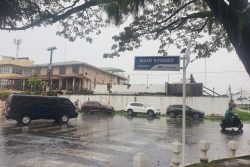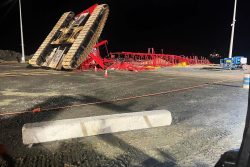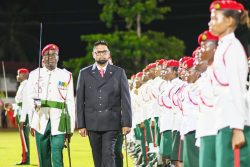-US think tank
Following its February 7th report, a US think tank says Venezuela is continuing to build up forces along Guyana’s border and there are risks of escalation with elections approaching in July and even after that.
In a piece yesterday entitled `The Essequibo Pressure Cooker: Runaway Nationalism and Maduro’s Compellence Strategy’, the US Center for Strategic and International Studies (CSIS) said that even though Venezuela President Nicolás Maduro is highly unlikely to win the election in a fair race, examples are legion of the “rally around the flag” effect during international crises, even if only in the short term and this is what he is doing with country’s claim to Essequibo.
In its February 7th piece, CSIS cited the concept of “compellence” where Venezuela is employing a carrot and stick policy to force concessions from Guyana.
While the recent escalation over the Essequibo region has not reached the level of kinetic action, CSIS said that the Maduro regime’s rhetoric, which, in part, aims to provide the armed forces a raison d’être, “has likely unleashed a genie that will be difficult to put back in the bottle”.
Georgetown has not commented much about Venezuela’s military build-up and an attempt by APNU+AFC MP Amanza Walton-Desir to ask a question in Parliament last week on the matter was shot down by the Speaker Manzoor Madir. The Speaker said that the question violated the Standing Orders.
CSIS said yesterday that Maduro and the armed forces have rhetorically committed to defending the newly created region, and the establishment of “Guayana Esequiba” (Essequibo) opens the door to potential illegal settlements, encroachments, or border skirmishes.
“To be sure, Maduro is unlikely to initiate a full-blown conflict with neighbor Guyana, but his escalatory rhetoric tethers his political reputation and legitimacy to his willingness to back his words with force. While the period between now and July 28 is a risky time for Maduro, there is also a risk he may seek to manufacture a crisis after the election, too”, the analysis said.
Since early February, CSIS said that the National Bolivarian Armed Forces of Venezuela (FANB) have moved substantial quantities of personnel and equipment to sites near the border. In particular, the military base at Ankoko Island, as well as the airport and coast guard station at Guiria, have seen considerable activity based on social media and satellite imagery analysis.
Construction and expansion of the military base on Ankoko Island – Guyana’s half of which was seized by Venezuela – has proceeded at a sustained pace. Social media and satellite imagery both show progress in the building of the bridge over the Cuyuni River to the island, and new pathways now connect the island to the ferry landing. As recently as May 8, CSIS said that video can be seen of a Bailey bridge extending some distance over the river, likely a temporary connection while a more permanent connection is created. A narrow-gauge railroad, no trace of which existed in February, is now being built from the ferry crossing toward the airfield, and once completed it would presumably bring supplies from the airfield to the base and nearby towns, CSIS said.
The airfield has been enlarged and improved with markings and a small control tower. CSIS said that satellite imagery from Maxar from March 26 shows an area next to the airfield with over 75 field tents, enough for a battalion-sized unit of several hundred personnel.
It said that according to a press release from the Venezuelan air force on April 21, a C-130 Hercules was involved in a training mission to land and take off from the dirt runway.
“Meanwhile, the aircraft and the base at (Ankoko) were used to train paratroopers and special operations personnel, as well as to simulate land and maritime operations. As of April 28, the field tents have been relocated to the southern side of the airfield, demonstrating the base’s continued ability to provide logistics and resupply for a sizeable military force continuously for over a month”, CSIS asserted.
It added that the FANB has increasingly brought airpower into play in the maritime domain as well.
“Video dated February 24 and shared by General Domingo Hernández Lárez, the head of the FANB’s Strategic Operational Command, shows two K-8W light attack aircraft patrolling the Atlantic Coast from Guiria. Their tails display the message `El Esequibo es Nuestro’ (`The Essequibo is Ours’), and their stated mission was to `exercise sovereignty in the Atlantic’”, the analysis said.
Three planes, whose dimensions are consistent with K-8Ws, can be seen on satellite imagery taken of the Guiria airport on March 28. Parked beside the jets, the imagery showed, are two Buk-M2EK antiaircraft missile launchers, likely the same that were deployed to the city in late January. Further, a number of military-affiliated social media accounts have been telegraphing that they are projecting power into the Atlantic from Guiria, sharing imagery of combined arms patrols with Su-30 fighter jets, possibly over portions of the disputed waters between Guyana and Venezuela.
At the coast guard station in Guiria, the analysis said that social media posts from April 5 show a Los Frailes-class landing ship, T-95 Las Aves, unloading a fresh complement of Zolfaghar missile boats. Satellite imagery from April 13 confirmed an increased naval presence in Guiria, showing five Zolfaghars moored together at the coast guard dock, along with two patrol boats, possibly one Págalo-class vessel and one Gavión-class vessel. Sources differ, however, over the true extent of Venezuela’s current naval power in Guiria, the analysis added. Some reports claim three boats were delivered, though from video shared on social media it appears that only two were actually unloaded. Given that CSIS found three Zolfaghars already at the Guiria station on January 28, this uncertainty means it is possible that there are between five and six missile boats in the area, out of an estimated seven total in the Venezuelan navy’s service.
It is also possible that if three Zolfaghars were delivered to Guiria, Venezuela’s navy has more than seven of these ships, CSIS added. Reporting by Straight Arrow News suggests that the Venezuelan navy acquired new boats after the December 3, 2023, referendum on the Essequibo, but no source for that information was given.
“Regardless of the true number, the new Zolfaghars in Guiria point to a significant concentration of firepower for a comparatively minor coast guard installation far from the FANB’s main facilities in La Guajira and Puerto Cabello. As of May 8, at least two of the Zolfaghars, alongside one Págalo patrol vessel, appear to have arrived at Punta Barima, a secondary coast guard station that CSIS reported in February was undergoing upgrades as part of Venezuela’s military buildup. This development marks an even more concerning escalation, placing Venezuelan missiles and naval forces within arm’s reach of the Guyana-administered Essequibo”, CSIS asserted.
Arguing that the Venezuelan military is making a concerted effort to intimidate, threaten, and coerce Guyana, the analysis asks where does this end?
“As in so many other facets of his regime, such as the pending NGO law, Maduro has engaged in `authoritarian learning’ and aped his idol, Vladimir Putin. Scholars writing on Russia’s war in Ukraine noted Putin’s domestic transition to a war footing well before the full-scale invasion—indeed, even well before the first invasion of `little green men’ in Crimea. For example, Leon Aron writes of a sense of `militarized patriotism in peacetime,’ referring to Russian propaganda that even during peacetime, Russia faces an external threat landscape tantamount to a near state of war.
“Similarly, Maduro may be leveraging a conjured sense of impending conflict during peacetime. He has saturated Venezuela with propagandist claims about Guyana’s government—that it does not exist and is in fact run by ExxonMobil, United States Southern Command, and the Central Intelligence Agency—and that any move by Guyana to bolster its defenses should be interpreted as an offensive preparation for war, mostly impelled and directed by the United States and its corporations”, the analysis added.
It contended that as Maduro’s domestic position has eroded, challenged by a more effective opposition, the Venezuelan President has become even more beholden to the armed forces and hopes to receive several things in return for the armed forces accreting more power.
Arguing that Maduro has little to gain and much to lose from a full-blown conflict as even against a militarily inferior opponent, the FANB would face significant obstacles conducting complex operations in an unforgiving environment, blatant aggression would also isolate Maduro from the international community he appears keen to rejoin, and it could galvanize support for multilateral sanctions.
CSIS warned however that as with Putin’s invasion of Ukraine, the lesson of February 22, 2024, is that dictators do not always act rationally.
“…the Venezuelan government is playing a dangerous game with its rhetoric and actions around the Essequibo. The constant drumbeat asserting `the Essequibo is ours,’ alongside the creation of new military commands and legal structures to oversee the defense of the region, is helping to institutionalize a sense of perpetual prewar footing”, it warned.







